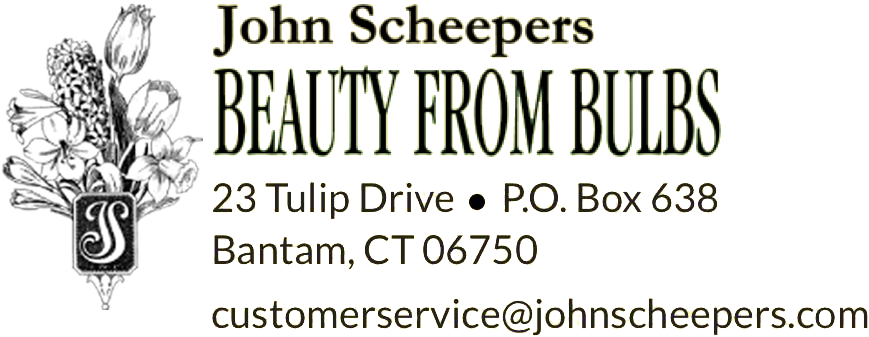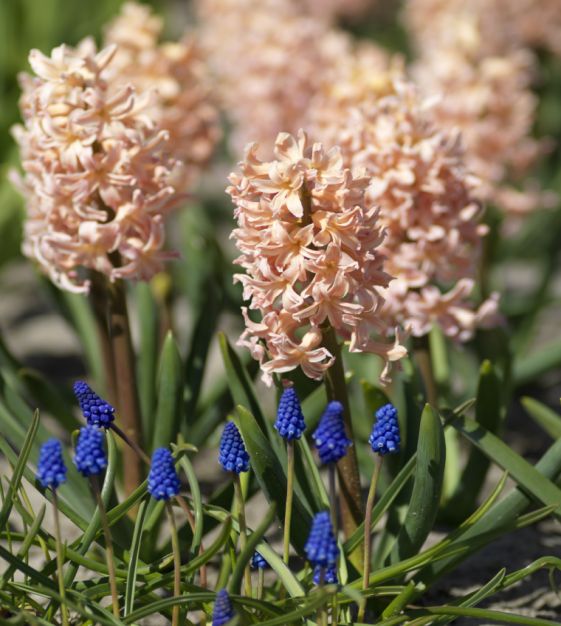-
- 20%-Off Website Specials
- New for 2024!
- Tulips
- Narcissi
- Allium
- Anemone blanda
- Brodiaea
- Camassia
- Chionodoxa
- Corydalis
- Crocus
- Eranthis
- Eremurus
- Erythronium
- Fritillaria
- Galanthus
- Geranium
- Gladiolus
- Hyacinths
- Hyacinthoides
- Ipheion uniflorum
- Dutch Iris
- Rock Garden Iris
- Ixiolirion
- Leucojum Aestivum
- Muscari
- Ornithogalum
- Oxalis
- Puschkinia
- Scilla
- Lilies
- Peonies
- Tender Bulbs
- Anemone Giants
- Tecolote Ranunculus
- Freesias
- Paperwhites
- Amaryllis
Hyacinthus orientalis Gypsy Queen
H. orientalis Gypsy Queen, dating back to 1927, has more slender flowering racemes with florets, or nails, in luscious tones of salmon-apricot tinged pink with paler petal edges. It is known to be a good forcer. Bulb size: 16/17 cm. Full to partial sunlight. Bloom time in horticultural zone 5: April. Plant 6" deep and 6" apart. HZ: 4-8. Height: 8" to 12".
Hyacinths are The Art, Soul and Fragrance of Spring.
Hyacinth Horticultural Tips Hyacinth Forcing Tips
Hyacinths are The Art, Soul and Fragrance of Spring.
Hyacinth Horticultural Tips Hyacinth Forcing Tips
- Information
Hyacinths
There are few flowers more iconic or glorious than Hyacinths: they are the art, soul and fragrance of spring. Known to be deer- and rodent-resistant, they are much loved by happily bumbling bees and helpful pollinators. The original species, Hyacinthus orientalis, was found in the wild of the eastern Mediterranean around 1562. The sweet perfume and colorful rainbow of Hyacinthus orientalis has filled the finest of gardens since 1850 or so when the Dutch began extensive hybridization.
For well over a century, Dutch Hyacinths have not only been the rage in display gardens. They have also been the object of obsession as flowers forced in glass vases. These were not always simple glass vases that supported the bulb over water either. Hyacinth vases were also exquisite blown-glass vessels that were colored, etched, enameled and intricately adorned to enhance the extraordinary beauty and prestige of forced Hyacinths, particularly in Victorian era stately homes from the mid 1830s through the 20th century.
Hyacinthus orientalis yield plump, rigid racemes densely compacted with slightly reflexed, tubular florets, also known as nails, and three to four, upright strappy leaves. While hybrids with single florets or nails are the most prolifically grown, there are semi-double and double forms of Hyacinthus orientalis being grown today. Our favorite is Royal Navy.
We must mention that some people develop an itchy reaction to touching Hyacinth bulbs. If you ever have had such an irritation, or if you don’t know how you will respond to touching Hyacinth bulbs, it is best to wear protective garden gloves. Take care not to touch your face or rub your eyes with your gloved hands. There is nothing to worry about if you do have an itchy reaction, as annoying as it may be. Just wash the affected area with soap and water. Some people have no reaction to them, others have strong reactions to them. To be on the safe side, it’s best to not include your children in planting Hyacinth bulbs.
You’ll need about four bulbs per square foot. Bulb size: 16/17 cm (except for the Hyacinth Bedding Mixture that is 15/16 cm and the Hyacinth Forcing and Exhibition Collection that is 18/19 cm). Full to partial sunlight. Bloom time in horticultural zone 5: April. Plant 6" deep and 6" apart. HZ: 4-8. Height: 8" to 12".
Hyacinths are The Art & Soul of Spring.
Hyacinth Horticultural Tips Hyacinth Forcing Tips
There are few flowers more iconic or glorious than Hyacinths: they are the art, soul and fragrance of spring. Known to be deer- and rodent-resistant, they are much loved by happily bumbling bees and helpful pollinators. The original species, Hyacinthus orientalis, was found in the wild of the eastern Mediterranean around 1562. The sweet perfume and colorful rainbow of Hyacinthus orientalis has filled the finest of gardens since 1850 or so when the Dutch began extensive hybridization.
For well over a century, Dutch Hyacinths have not only been the rage in display gardens. They have also been the object of obsession as flowers forced in glass vases. These were not always simple glass vases that supported the bulb over water either. Hyacinth vases were also exquisite blown-glass vessels that were colored, etched, enameled and intricately adorned to enhance the extraordinary beauty and prestige of forced Hyacinths, particularly in Victorian era stately homes from the mid 1830s through the 20th century.
Hyacinthus orientalis yield plump, rigid racemes densely compacted with slightly reflexed, tubular florets, also known as nails, and three to four, upright strappy leaves. While hybrids with single florets or nails are the most prolifically grown, there are semi-double and double forms of Hyacinthus orientalis being grown today. Our favorite is Royal Navy.
We must mention that some people develop an itchy reaction to touching Hyacinth bulbs. If you ever have had such an irritation, or if you don’t know how you will respond to touching Hyacinth bulbs, it is best to wear protective garden gloves. Take care not to touch your face or rub your eyes with your gloved hands. There is nothing to worry about if you do have an itchy reaction, as annoying as it may be. Just wash the affected area with soap and water. Some people have no reaction to them, others have strong reactions to them. To be on the safe side, it’s best to not include your children in planting Hyacinth bulbs.
You’ll need about four bulbs per square foot. Bulb size: 16/17 cm (except for the Hyacinth Bedding Mixture that is 15/16 cm and the Hyacinth Forcing and Exhibition Collection that is 18/19 cm). Full to partial sunlight. Bloom time in horticultural zone 5: April. Plant 6" deep and 6" apart. HZ: 4-8. Height: 8" to 12".
Hyacinths are The Art & Soul of Spring.
Hyacinth Horticultural Tips Hyacinth Forcing Tips
Hyacinths
There are few flowers more iconic or glorious than Hyacinths: they are the art, soul and fragrance of spring. Known to be deer- and rodent-resistant, they are much loved by happily bumbling bees and helpful pollinators. The original species, Hyacinthus orientalis, was found in the wild of the eastern Mediterranean around 1562. The sweet perfume and colorful rainbow of Hyacinthus orientalis has filled the finest of gardens since 1850 or so when the Dutch began extensive hybridization.
For well over a century, Dutch Hyacinths have not only been the rage in display gardens. They have also been the object of obsession as flowers forced in glass vases. These were not always simple glass vases that supported the bulb over water either. Hyacinth vases were also exquisite blown-glass vessels that were colored, etched, enameled and intricately adorned to enhance the extraordinary beauty and prestige of forced Hyacinths, particularly in Victorian era stately homes from the mid 1830s through the 20th century.
Hyacinthus orientalis yield plump, rigid racemes densely compacted with slightly reflexed, tubular florets, also known as nails, and three to four, upright strappy leaves. While hybrids with single florets or nails are the most prolifically grown, there are semi-double and double forms of Hyacinthus orientalis being grown today. Our favorite is Royal Navy.
We must mention that some people develop an itchy reaction to touching Hyacinth bulbs. If you ever have had such an irritation, or if you don’t know how you will respond to touching Hyacinth bulbs, it is best to wear protective garden gloves. Take care not to touch your face or rub your eyes with your gloved hands. There is nothing to worry about if you do have an itchy reaction, as annoying as it may be. Just wash the affected area with soap and water. Some people have no reaction to them, others have strong reactions to them. To be on the safe side, it’s best to not include your children in planting Hyacinth bulbs.
You’ll need about four bulbs per square foot. Bulb size: 16/17 cm (except for the Hyacinth Bedding Mixture that is 15/16 cm and the Hyacinth Forcing and Exhibition Collection that is 18/19 cm). Full to partial sunlight. Bloom time in horticultural zone 5: April. Plant 6" deep and 6" apart. HZ: 4-8. Height: 8" to 12".
Hyacinths are The Art & Soul of Spring.
Hyacinth Horticultural Tips Hyacinth Forcing Tips
There are few flowers more iconic or glorious than Hyacinths: they are the art, soul and fragrance of spring. Known to be deer- and rodent-resistant, they are much loved by happily bumbling bees and helpful pollinators. The original species, Hyacinthus orientalis, was found in the wild of the eastern Mediterranean around 1562. The sweet perfume and colorful rainbow of Hyacinthus orientalis has filled the finest of gardens since 1850 or so when the Dutch began extensive hybridization.
For well over a century, Dutch Hyacinths have not only been the rage in display gardens. They have also been the object of obsession as flowers forced in glass vases. These were not always simple glass vases that supported the bulb over water either. Hyacinth vases were also exquisite blown-glass vessels that were colored, etched, enameled and intricately adorned to enhance the extraordinary beauty and prestige of forced Hyacinths, particularly in Victorian era stately homes from the mid 1830s through the 20th century.
Hyacinthus orientalis yield plump, rigid racemes densely compacted with slightly reflexed, tubular florets, also known as nails, and three to four, upright strappy leaves. While hybrids with single florets or nails are the most prolifically grown, there are semi-double and double forms of Hyacinthus orientalis being grown today. Our favorite is Royal Navy.
We must mention that some people develop an itchy reaction to touching Hyacinth bulbs. If you ever have had such an irritation, or if you don’t know how you will respond to touching Hyacinth bulbs, it is best to wear protective garden gloves. Take care not to touch your face or rub your eyes with your gloved hands. There is nothing to worry about if you do have an itchy reaction, as annoying as it may be. Just wash the affected area with soap and water. Some people have no reaction to them, others have strong reactions to them. To be on the safe side, it’s best to not include your children in planting Hyacinth bulbs.
You’ll need about four bulbs per square foot. Bulb size: 16/17 cm (except for the Hyacinth Bedding Mixture that is 15/16 cm and the Hyacinth Forcing and Exhibition Collection that is 18/19 cm). Full to partial sunlight. Bloom time in horticultural zone 5: April. Plant 6" deep and 6" apart. HZ: 4-8. Height: 8" to 12".
Hyacinths are The Art & Soul of Spring.
Hyacinth Horticultural Tips Hyacinth Forcing Tips





